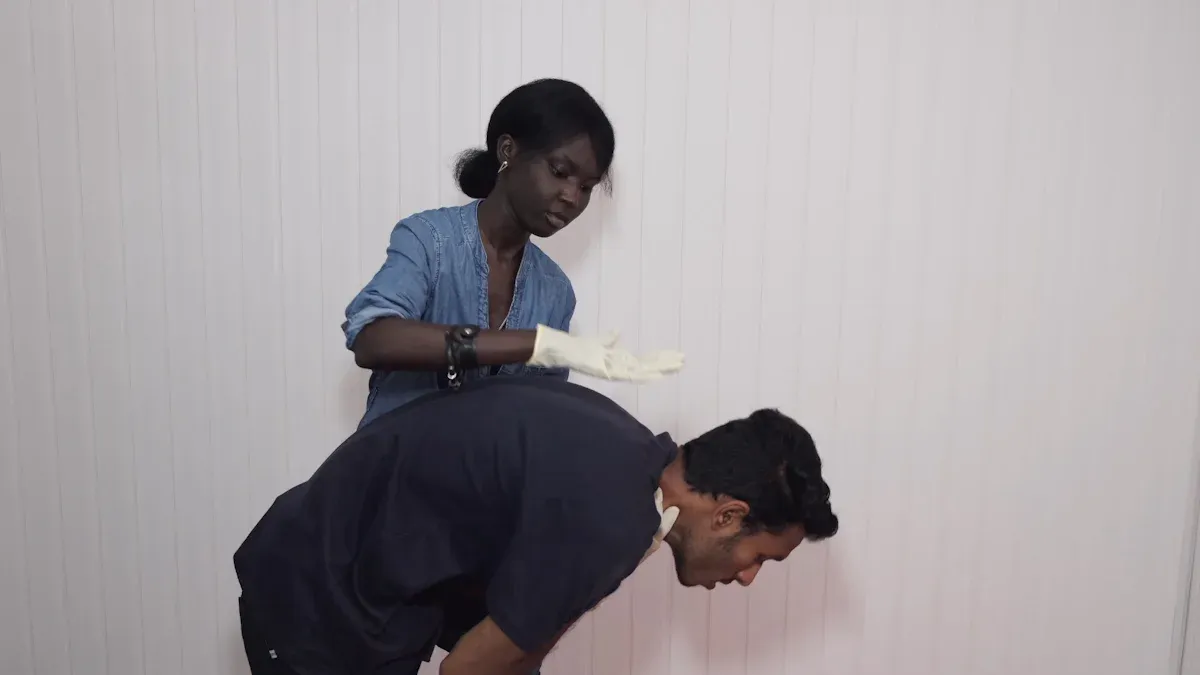How to troubleshoot Helius flashlight battery issues and restore power

We’ve all been there—your helius flashlight suddenly won’t turn on, leaving you in the dark. It’s frustrating, right? Don’t worry, though. Most flashlight issues, whether it’s the battery or power connection, are fixable. By taking a step-by-step approach, you can get your helius flashlight working again in no time.
Key Takeaways
Check the battery for damage or wear. Replace it if it’s bulging or leaking to fix power issues.
Wipe battery contacts and ends often. This easy care stops flickering and keeps it working well.
Keep your flashlight in a cool, dry spot. Good storage keeps the battery strong and avoids leaks.
Identifying Power and Battery Issues

When your flashlight stops working, the first step is to figure out what’s wrong. Let’s break it down into a few simple checks to help you identify the problem.
Inspect the battery for damage or depletion
Start by taking a close look at the battery. Is it swollen, leaking, or showing any signs of damage? If so, it’s time to replace it. Batteries can also lose their charge over time, especially if they’ve been sitting unused. Try swapping in a fresh, compatible battery to see if that restores power. Remember, the role of batteries in flashlights is crucial—they’re the heart of the device. Without a reliable battery, even the best flashlight won’t work.
Check for loose or dirty battery connections
Sometimes, the issue isn’t the battery itself but how it connects to the flashlight. Loose or dirty connections can disrupt the flow of power. Remove the battery and inspect the terminals inside the flashlight. Are they clean and secure? If not, here’s what you can do:
Turn off the flashlight and remove the battery to ensure safety.
Check for dirt or debris and gently tap the flashlight to dislodge anything stuck.
Use a cotton swab dipped in a mix of vinegar and water to clean the contacts.
Dry everything thoroughly before reassembling the flashlight.
This simple cleaning process can often solve power and battery issues.
Look for signs of corrosion or dirt in the flashlight
Corrosion and dirt can build up over time, especially if the flashlight has been exposed to moisture. Check the battery compartment and the terminals for any greenish or whitish residue. Corrosion can block the electrical connection, making the flashlight unusable. If you spot corrosion, follow the cleaning steps mentioned earlier. Regular maintenance can also prevent future problems like battery leakage or dirt buildup.
By carefully inspecting these areas, you’ll often find the root cause of the problem. Once you’ve identified the issue, you’re one step closer to getting your flashlight back in action.
Step-by-Step Troubleshooting for a Flashlight Not Turning On

Clean the battery contacts and terminals
Dirty or corroded battery contacts can stop your flashlight from working. Cleaning them is simple and can often solve the problem. Follow these steps:
Turn off the flashlight and remove the batteries for safety.
Check the contacts for corrosion or dirt. Gently tap the flashlight to dislodge debris.
Mix equal parts vinegar or lemon juice with water to create a cleaning solution.
Use a cotton swab dipped in the solution to scrub the contacts.
Wipe away any moisture and let the flashlight dry completely before reassembling.
Tip: Always wear gloves and eyewear when cleaning to protect yourself from harmful substances.
Regular maintenance like this can prevent future issues, such as dim light or flickering light caused by poor connections.
Replace the battery with a fresh, compatible one
If cleaning doesn’t work, the battery might be the issue. Use a fresh, compatible replacement. Helius flashlights work well with lithium, NiMH, or Li-ion rechargeable batteries. These options provide long runtimes and consistent power. Avoid using low-quality batteries, as they can lead to a broken rechargeable flashlight over time.
Tighten all flashlight components to ensure proper contact
Loose components can cause inconsistent illumination or even a flashlight not turning on. Check the battery compartment, tail cap, and other parts. Tighten them securely to ensure proper contact. This simple step can often resolve flickering light or power issues.
Test the flashlight after each step to isolate the issue
After completing each step, test the flashlight. This helps you pinpoint the exact cause of the problem. If none of these steps work, you may need to explore advanced fixes or consider professional help for fixing the flashlight.
Advanced Fixes for Persistent Issues
Sometimes, basic troubleshooting doesn’t solve the problem. If your flashlight still won’t turn on, it might be time to dig a little deeper. Let’s explore some advanced fixes to get your flashlight shining again.
Check internal wiring for loose or damaged connections
Loose or damaged wires inside the flashlight can disrupt the flow of power. To inspect the wiring, you’ll need a few tools:
Precision Utility Knife
Nitrile Gloves
iFixit Precision 4 mm Screwdriver Bit
iFixit Opening Picks
Start by carefully disassembling the flashlight. Look for any disconnected or frayed wires. If you spot a problem, use a precision utility knife to strip the wire ends and reconnect them securely. Always wear nitrile gloves to protect your hands and avoid static damage to the flashlight’s components.
Replace faulty components, such as the switch or circuit board
If the wiring looks fine, the issue might lie with the switch or circuit board. A faulty switch can prevent the flashlight from turning on, while a damaged circuit board can interrupt power flow. Replacing these parts requires precision. You can order replacement components online or from a flashlight repair shop. Make sure the new parts are compatible with your flashlight model.
Seek professional repair services if necessary
If you’re unable to fix a broken flashlight on your own, don’t hesitate to seek professional help. A skilled technician can diagnose and repair complex issues, ensuring your flashlight works like new. This is especially helpful if you’ve already tried replacing the battery and inspecting the wires without success.
By addressing these advanced issues, you can restore your flashlight’s functionality and avoid the frustration of being left in the dark.
Preventing Short Battery Life and Future Problems
Store the flashlight in a cool, dry place
Where you store your flashlight can make a big difference in how long it lasts. Extreme temperatures and humidity can wreak havoc on both the flashlight and its battery. Here’s why you should always keep it in a cool, dry spot:
High temperatures can speed up chemical reactions in the battery, increasing the risk of leakage.
Cold environments can damage internal components and reduce runtime.
Moisture can lead to corrosion, which may cause malfunctioning switches or poor connections.
By storing your flashlight properly, you’ll maintain the health of your flashlight battery and avoid unnecessary damage. A little care now can save you from bigger problems later.
Remove the battery when not in use for extended periods
If you’re not planning to use your flashlight for a while, take the battery out. Leaving it inside can lead to leakage, especially with alkaline batteries. This leakage can ruin the flashlight’s internal components. For long-term storage, consider using lithium batteries. They’re less likely to leak compared to alkaline or heavy-duty options. Removing the battery also prevents slow discharge, which helps maintain a long battery life.
Tip: Always check the battery type before adding batteries to the flashlight. Selecting batteries based on flashlight type ensures optimal runtime and performance.
Regularly clean and inspect the flashlight to prevent buildup or damage
Easy maintenance and troubleshooting go hand in hand. Cleaning your flashlight every six months can prevent dirt and debris from building up. If you use it daily, inspect it monthly to catch any issues early. For occasional use, a bi-yearly check-up works well. Regular maintenance keeps your flashlight in top shape and ensures consistent runtime.
To clean, wipe down the exterior and check the battery compartment for any signs of corrosion. A quick inspection can help you spot problems before they escalate. This simple habit will help you maintain the flashlight’s performance and extend its lifespan.
By following these steps, you’ll not only prevent short battery life but also ensure your flashlight is always ready when you need it.
Troubleshooting your Helius flashlight doesn’t have to be complicated. By inspecting the battery, cleaning contacts, and tightening components, you can restore power quickly. Regular maintenance is key to keeping your flashlight in top shape. Clean it often, store it properly, and remove the battery when not in use. These habits ensure consistent performance and reliability. Taking care of your flashlight now saves you from future headaches. Keep it ready for any situation!
FAQ
What should I do if my flashlight flickers while in use?
Check the battery connections and tighten all components. Loose parts often cause flickering. Cleaning the contacts can also restore consistent power.
Can I use any type of battery for my Helius flashlight?
No, always use compatible batteries like lithium or NiMH. Using the wrong type can damage the flashlight or reduce its performance.
How often should I clean my flashlight?
Clean it every six months or after heavy use. Regular cleaning prevents dirt buildup and ensures your flashlight stays in good working condition.
See Also
In-Depth Review of the Heliusworld Flashlight Model
Key Strategies for Keeping Your Flashlight in Top Shape
Explore the Helius Lantern Flashlight with 200-Hour Battery Life
How to Prolong Your Flashlight's Battery Life Effectively
Helius Tactical Flashlight: Brightening Your Outdoor Experiences
